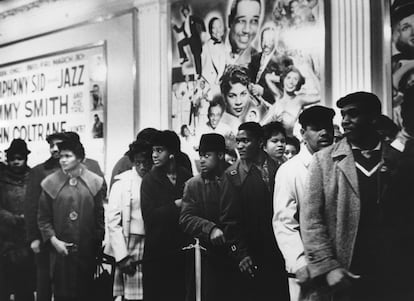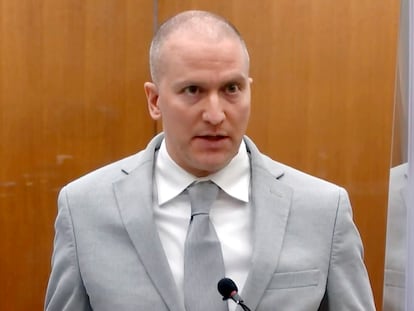How Harlem’s Apollo Theater created not just music and culture but a community identity
The best Black artists of the 20th century performed at the legendary venue, but the establishment was much more than a showcase for talent at a time of racial segregation in the U.S.

That Black lives matter was already a well-known fact in the United States in 1964. On a month of July 59 years ago, a white police officer shot dead a 15-year-old Black teen named James Powell in Harlem, New York. Residents of the neighborhood took to the streets to protest and major riots broke out. Amid the chaos and looting on 125th Street, no one touched a single pane of the Apollo Theater. That place was sacred: it had been a temple to the African-American community, locally and across the country, for decades. And it still is today.
The story of the establishment was explored in the 2019 documentary The Apollo, available on HBO Max. Director Roger Ross Williams did not just craft a story about the most legendary venue in Harlem, or even a story of Harlem itself; it is the story of 85 years of struggle by Black citizens to have their dignity recognized through everything that happened inside a hall with seating for 1,600 people. From that spot, a vibrant cultural scene was projected throughout the United States and the entire world, and it began in the harshest years of racial segregation. The theater had been built in 1913, and it functioned as a cabaret for whites until in 1934 it became one of the few non-segregated spaces in the city. Those were the years of what was called the Harlem Renaissance.
From this oasis of freedom and creativity emerged great figures in music (jazz, soul, blues, rock and roll, rap, hip-hop), comedy, vaudeville, dance and poetry. And through that art, the conscience of a people whose grandparents came out of slavery and who continued to suffer discrimination was strengthened.
Ella Fitzgerald performed at the talent shows at this venue (the Amateur Nights are still held every Wednesday) at the age of 17 in 1934; three decades later Jimi Hendrix would win a prize at the age of 21. It was here that James Brown pronounced his famous “I’m Black and I’m proud”, here that he performed around 200 times and here that a wake was held after his death in 2006. It was here that Billie Holiday sang the disturbing song Strange Fruit, which denounced the lynching of Black men.
Duke Ellington, Aretha Franklin, Louis Armstrong, Sarah Vaughan, Ray Charles were here on many nights. Motown artists stopped here whenever they could: Stevie Wonder, The Supremes, The Temptations, Marvin Gaye, Diana Ross, The Miracles... Michael Jackson had performed here as a child; there was also a wake for him after his death in 2009. Those glory days are behind us, but performances by Jay-Z, Pharrell Williams, Alicia Keys and Bruno Mars are still fresh in everyone’s minds.
Roger Ross Williams (the first African-American to win an Oscar as a director, in 2010, for the documentary Music by Prudence) insists on drawing these parallels between the awareness of the Black population and the magic of the place where they best expressed their artistic ambition. The footage opens and closes with testimonies from relatives of victims of police brutality, an entrenched problem until today, to make it clear that the fight is not over. And he devotes a good part of the footage to explaining what life was like in a country segregated by race according to laws in force until the mid-1960s: we see that even the stars of the show were banned from accessing hotels, restaurants and elevators.
The documentary follows the evolution of the neighborhood, its rise as a cultural focus and its decline in the late 70s, tough years in New York, when the venue shut down for the first time. Then, as the Big Apple’s cultural scene developed, the Apollo became less profitable: it had few seats to compete with larger venues. But the neighborhood clung to its legend and continued to attract the best artists in the country (not just Black: U2, Red Hot Chili Peppers, Guns N’Roses, George Michael and Bruce Springsteen all performed here). It ended up under New York State protection through a foundation and remains open today, more as a talent pool than a magnet for the stars.
The documentary is an invitation to reflect on how identity is built. It is not enough to share problems, or a skin color, or a tragic past. The Apollo is a tribute to the importance for the community to have spaces for culture and leisure where one feels part of something bigger that includes, welcomes and embraces them. What went on at the Apollo for nearly 90 years has not only defined the part of America with African roots: it still defines an entire country. And, to a large extent, universal culture.
Sign up for our weekly newsletter to get more English-language news coverage from EL PAÍS USA Edition
Tu suscripción se está usando en otro dispositivo
¿Quieres añadir otro usuario a tu suscripción?
Si continúas leyendo en este dispositivo, no se podrá leer en el otro.
FlechaTu suscripción se está usando en otro dispositivo y solo puedes acceder a EL PAÍS desde un dispositivo a la vez.
Si quieres compartir tu cuenta, cambia tu suscripción a la modalidad Premium, así podrás añadir otro usuario. Cada uno accederá con su propia cuenta de email, lo que os permitirá personalizar vuestra experiencia en EL PAÍS.
¿Tienes una suscripción de empresa? Accede aquí para contratar más cuentas.
En el caso de no saber quién está usando tu cuenta, te recomendamos cambiar tu contraseña aquí.
Si decides continuar compartiendo tu cuenta, este mensaje se mostrará en tu dispositivo y en el de la otra persona que está usando tu cuenta de forma indefinida, afectando a tu experiencia de lectura. Puedes consultar aquí los términos y condiciones de la suscripción digital.
More information
Archived In
Últimas noticias
Tiger Woods turns 50: Will he continue playing on the PGA Tour or take a back seat?
The surreal journey of James Nnaji, the Barcelona youth player selected in the NBA Draft who ended up in the NCAA
Trump claims peace in Ukraine is near, but Moscow suggests otherwise
A survivor’s account of the Interoceanic Train accident: ‘We were scared because of the speed on the curve’
Most viewed
- Oona Chaplin: ‘I told James Cameron that I was living in a treehouse and starting a permaculture project with a friend’
- Reinhard Genzel, Nobel laureate in physics: ‘One-minute videos will never give you the truth’
- Why the price of coffee has skyrocketed: from Brazilian plantations to specialty coffee houses
- Pablo Escobar’s hippos: A serious environmental problem, 40 years on
- Chevy Chase, the beloved comedian who was a monster off camera: ‘Not everyone hated him, just the people who’ve worked with him’











































